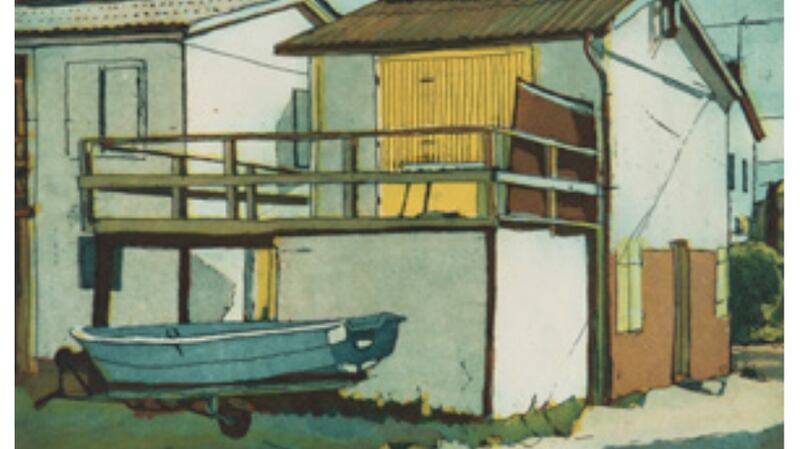Efference Copy Mechanism ★★★★
Ronan McCrea. Temple Bar Gallery, 5-9 Temple Bar, Dublin Until April 13th templebargallery.com
Efference Copy Mechanism recalls last year's Douglas Hyde Gallery mega-installation by Sven Anderson and Gerard Byrne, A Visibility Matrix. Drawing on imagery from a substantial panel of contributors on multiple screens, in configurations determined by a computer programme, that work was – and is – something like an evolving representation of online video-sharing platforms. It is, though, an account charged with an awareness of the idealistic, utopian ambitions of video-sharing pioneers from the 1960s to the 1980s. Those early ambitions have been largely thwarted by commercial and other imperatives.
McCrea’s title refers to the copies of motor signals transmitted throughout the nervous system as a means of maintaining stability and coherence within the system as a whole. Where Anderson and Byrne encapsulated an internet-like network, the core of McCrea’s installation is a kind of unorthodox self-portrait. Archival steel shelving occupies the centre of the darkened gallery space. From there, various film and slide projectors, looping contraptions and control boxes project imagery in three directions.
An accompanying text refers, reasonably enough, to the central arrangement as the show’s spine, but you could almost say its brain. Notes, sketches and other items arranged on a pinboard in the window indicate a preparatory working process. The shelves inside are stocked with what might be termed the artist’s mental baggage, an accumulated store of his ideas, preoccupations, obsessions and anxieties, all exemplified in the non-stop effusion of imagery, still and moving, and in one case almost imperceptibly moving, projected onto the walls.
Superimposed
There are three distinct projections. Twelve by Twelve by Two consists of two superimposed streams of 35mm slides. The actual images are drawn from 12 categories of image from McCrea's archive. Hence what unfolds is like rummaging around in his head. His interest in found images looms large. Included in the mix are, for example, "pictures of uninhabited zoo environments, seascapes, hand gestures. a collection of mid-century glassware . . ." and so on. Instructional sequences are an enduring preoccupation with him.
The rigour of the process – ordering exact kinds of image in modular temporal sequences – together with his penchant for pedagogic representational techniques, suggests a purposeful intent that the underlying logic precludes. The process leads us on but the logic actually refers us back to the structure, which brings to mind the term “minimalism”. McCrea does mention minimalism, as well as 12-tone serial music, as points of reference.
Superimposition is also employed in the film projection, Structures of Feeling (Superimposition), which overlays two pieces of 16mm film of differing length, hence producing endlessly evolving visual hybrids. The films are unlikely bedfellows: a chunk of Robert Flaherty's classic Man of Aran from 1934 and a shorter sequence from a Soviet-era educational film of unspecified date, The Structure of Atoms. McCrea takes his title from cultural theorist Raymond Williams's idea that emergent "different ways of thinking" might compete at any particular historical moment. If accepted, one of those ways of thinking might characterise a generation or a society.
Process of contention
McCrea surely has in mind the process of contention. His choice of material could be seen as symbolising the Enlightenment as opposed to the Romantic sensibility; for example, rationality versus subjectivity. The final project, North Sea Dissolve, extends a sequence of 24 slides of a seascape, shot in a matter of seconds, to 7½ minutes, generating almost imperceptible shifts in visual detail. Film, this seems to underline, messes around with time.
This show, and his entire back-catalogue, confirms his fascination with the materiality of film and of the analogue image. In relation to North Sea Dissolve he mentions Marcel Broodthaers's 1974 work, a book and a film (though Broodthaers preferred not to label things so definitely as book or film), A Voyage on the North Sea, inspired by an anonymous maritime painting he bought. Given Broodthaers's absolute absorption in the materiality of film, canvas, paint and image in this one work, one can see its appeal for McCrea. It is a fascinating show, all the more so when viewed as a direct insight into what might be termed the artist's predicament.

The Works: 30 years of the B&A/Graphic Studio Dublin Commission
Graphic Studio Gallery, Through the Arch, Cope St, Temple Bar, Dublin. Until March 9th graphicstudiogallery.com ★★★★
Behaviour & Attitudes was a young company, a bit of an upstart breakaway from the existing culture of market research, when it embarked on what became one of the most remarkable – and durable – art and business collaborations in 1989: commissioning original fine art prints through the Graphic Studio as an alternative to the more conventional annual offerings to clients and associates. In fact, the process had begun the year before, when a collaborative book by poet Paul Durcan and painter Gene Lambert was the nominated gift. But commissioning art at source was a brave and innovative step.
It was a trial scheme, but it proved to be exceptionally popular with recipients. Over the years, it has drawn in an impressive roll-call of artists. An early, emergent gender imbalance was in time corrected and, almost by accident, B&A has built up a fine collection of Irish graphic art. This show marks the 30th anniversary, and includes a wealth of work from Donald Teskey, Maria Simonds-Gooding, Hughie O’Donoghue, Taffina Flood, Colin Martin, Pamela Leonard, Gwen O’Dowd, Mary Lohan and more. It’s been a boon for the Graphic Studio given that part of its mission has always been to spread the gospel of the fine art print.


















